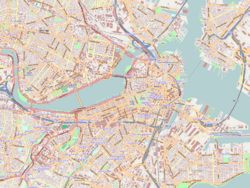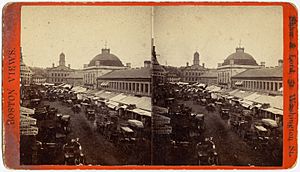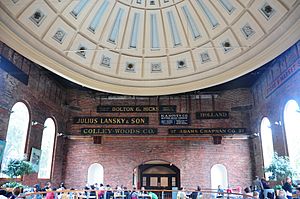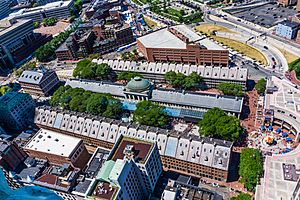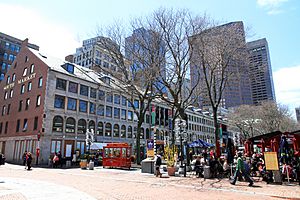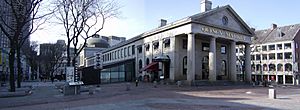Quincy Market facts for kids
|
Quincy Market
|
|
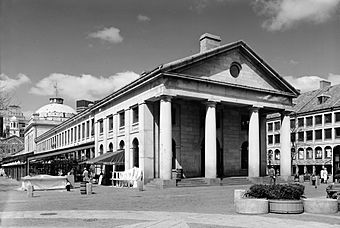
Quincy Market, east side, 1987
|
|
| Location | Boston, Massachusetts |
|---|---|
| Built | 1825 |
| Architect | Alexander Parris G.J.F. Bryant |
| Architectural style | Greek Revival |
| NRHP reference No. | 66000784 |
Quick facts for kids Significant dates |
|
| Added to NRHP | November 13, 1966 |
| Designated NHL | November 13, 1966 |
Quincy Market is a famous old building in Downtown Boston, Massachusetts. It stands right next to Faneuil Hall. This market was built a long time ago, between 1824 and 1826. It was named after Mayor Josiah Quincy, who helped get it built without using any tax money or creating debt.
Quincy Market is a very important historical place. It's known as a National Historic Landmark and a Boston Landmark. It was one of the biggest market places built in the United States in the early 1800s. It's also important to remember that this area has a long history, and some difficult events from Boston's past, like early slave auctions, happened nearby.
Today, Quincy Market is the main building of the Faneuil Hall Marketplace. People often use "Quincy Market" to talk about the whole shopping and restaurant area. In the middle of the 1900s, the market needed a lot of repairs. It was completely updated in the early 1970s and opened again in 1976. Now, the marketplace includes the original Quincy Market building, plus the North Market and South Market buildings on its sides. Faneuil Hall is at one end, and two smaller curved buildings are at the other.
Contents
A Look Back: Quincy Market's History
When Boston became a city in 1822, there were so many businesses that Faneuil Hall wasn't big enough anymore. To make more room for shops, Quincy Market was built. It was designed as an indoor place with many stalls for vendors.
The famous architect Alexander Parris designed the main building. It was built just east of Faneuil Hall, which used to be right by the water. To create space for the new market, part of the harbor was filled in with dirt. This is an early example of how Boston grew by adding land. The new market brought so much business that six new city streets were built or improved.
From the very beginning, Quincy Market was mostly a place to buy fresh food. You could find eggs, cheese, bread, and other groceries inside. When workers dug up the area in the late 1970s, they found animal bones. This suggests that meat was prepared right there at the market. Outside the building, street vendors also set up their stalls. You can still see some old signs from early food merchants in the upstairs seating area today.
Quincy Market's Unique Design
The market building has two floors. It is about 535 feet (163 meters) long and covers 27,000 square feet (2,508 square meters) of land. The outside is mostly made of granite, and the inside walls are red brick. It was one of the first large buildings to use granite and glass with a special type of wood frame construction. Inside, it uses strong cast iron columns and iron rods to hold everything together.
The east and west ends of the building look like ancient Roman architecture, with large triangular tops called pediments and strong Doric columns. But the sides of the building look more modern and American, with many rectangular windows.
The building is a long rectangle, with a wide hallway running down its middle. On the roof, there are eight chimneys spaced out evenly. In the very center of the building, there's a copper dome. This dome covers a large open area where people can sit and eat. It's also where the main side entrances are located.
On either side of the main market building are two other buildings, the North Market and the South Market. These are 4.5 stories tall and made of brick and granite. They were part of the original market plan. These side buildings have been changed more over the years than the main building. The entire market area was named a National Historic Landmark in 1966. The central domed building was also named a Boston Landmark in 1996. The North and South Market buildings are expected to become Boston Landmarks soon.
The Modern Faneuil Hall Marketplace
By the early 1970s, Quincy Market was getting old and run down. Most of Boston's meat and produce businesses had moved to newer, bigger places. In 1969, the city of Boston received about $2 million to help fix up the market. The goal was to make the roofs and outside walls look like they did in 1826.
Then, a company called Rouse Company and architects Benjamin Thompson and Associates came up with a new idea. They created a "festival marketplace" using both public and private money. The new Faneuil Hall Marketplace, which included Quincy Market, opened in 1976. It quickly became a huge success and won important awards for its design.
Today, the main Quincy Market building is still a popular place for food. Instead of grocery stalls, it now has many food stalls, fast-food places, and restaurants. It's a very busy spot for people working downtown to grab lunch. In the center, under the dome, there's a two-story area where people can sit and eat.
Outside the building, especially on the south side, there are more street vendors under a glass cover. These stalls often sell small gifts, souvenirs, and interesting items. A few restaurants also have fully enclosed spaces at the ends of this area.
On the second floor and in the basement, you can find more shops. There used to be a big comedy club there, and now bars and restaurants are in the basement.
The North Market and South Market buildings on either side of the main market also have more restaurants, unique shops, and offices. At the east end of the marketplace, two curved buildings create a circular plaza.
The open areas at both ends of the marketplace are great places to see street performers. You'll often find a crowd watching jugglers or other acts during the day. It's a lively and fun place to visit!
See also
- Festival marketplace
- The Rouse Company
- List of National Historic Landmarks in Boston
- National Register of Historic Places listings in northern Boston, Massachusetts


